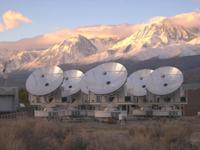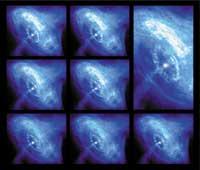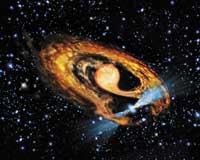The eventful history of pulsar
2007/09/23 Rementeria Argote, Nagore - Elhuyar Zientziaren Komunikazioa

The first pulse was detected in the nebula of M1 or Crab, at 6,300 light-years of the Earth. (Photo: ANDA-JPL )
Press XX. It was one of the most prestigious discoveries of astronomy of the twentieth century. According to scientific books, the first pulsar was seen by a astronomer from Northern Ireland called Bell Burnell. The signal that came to him regularly surprised him, were pulses of less than a second. What was it? Perhaps an alien sign? It could be.
The explanation was later discovered by astronomers: the pulse is a neutron star that rotates, emits electromagnetic waves (radio waves, X-rays or gamma) through the poles and on each tour comes a short period of waves to the Earth.
At the time of the discovery, dating back to the 1960s, Burnell was a student researcher at the University of Oxford, and was the first scientific article on the pulsar, written and signed by him and his research chief, the radioastrophysicist Anthony Hewish. For this article he received the Nobel Prize in Physics in 1974. Did Burnell not deserve part of the Nobel Prize? Currently Burnell is a prestigious researcher (president of the International Astronomical Association, who made an unforgettable presentation at the congress that determined that it was not a Pluto planet) and after wondering about the Nobel prize he smiles with humor: the researchers do not receive the Nobel prize.

Belle Burnell is currently a well-known astronomer who took this photo in an extravagant presentation at a meeting of the International Astronomical Society, when Pluto lost his planetary character. (Photo: International Astronomical Association )
This phrase is missing to add something, which is that women researchers and students do not receive the Nobel Prize. And there are still men who have been awarded the Nobel Prize for their research as students or collaborators.
A military looking at the pulsar
These questions are written in the history of science, even if it is in the section of the quotes. But this other issue will hardly be included in this section. The truth is that a former U.S. military officer has said he himself had noticed a pulsar before the scientific community knew the news of the bracelets. He is called Schisler and worked in Alaska in the summer of 1967, responsible for a missile detection radar.
Because with that radar I received a signal every day at the same time. Taking into account this time, he calculated the exact position of the signal. A few days ago he collected data on this signal and with that data he addressed the Department of Astronomy of the University of Alaska. There he discovered that the pulse of the sign came from the Crab nebula, about 6,300 light years from the Earth. For months he continued to collect data from similar signals, not knowing what they were and not counting to his superiors what he was doing.

After a few years he discovered that these signals were pulsars and he learned of them in the media. And he realized that he surely set himself on those signs before no one. But as we have said, Schisler was not an astronomer, he was not a scientist, his job was to detect missiles on radar, so he will hardly enter the history of science despite being the first man to detect a pulsar for the first time.
Published in 7K.

Gai honi buruzko eduki gehiago
Elhuyarrek garatutako teknologia






